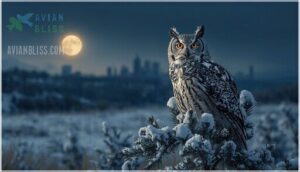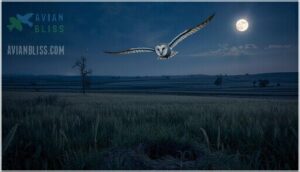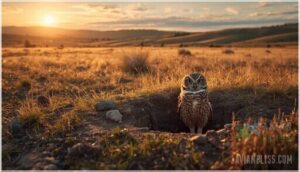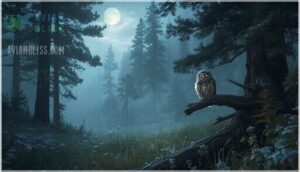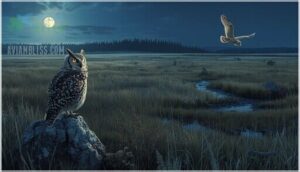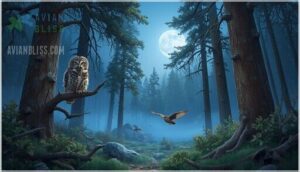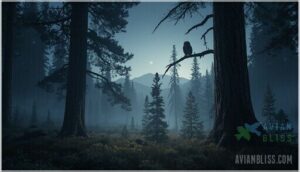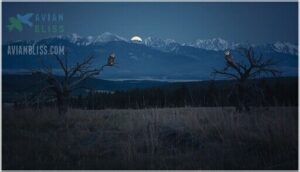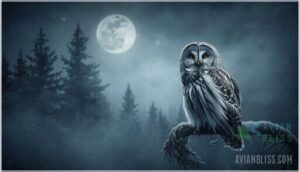This site is supported by our readers. We may earn a commission, at no cost to you, if you purchase through links.

Some owls here break the nocturnal stereotype entirely, hunting prairie dogs at midday or claiming abandoned burrows as condos.
Whether you’re scanning cottonwood groves along the Front Range or listening for hoots in a Ponderosa forest, knowing where each species lives—and what signs they leave behind—transforms a quiet evening walk into a front-row seat to Colorado’s most secretive predators.
Table Of Contents
- Key Takeaways
- Common Owl Species in Colorado
- Great Horned Owl: Widespread and Adaptable
- Barn Owl: Heart-Shaped Face and Silent Flight
- Burrowing Owl: Unique Ground-Dwelling Behavior
- Flammulated Owl: Tiny Forest Resident
- Short-eared and Long-eared Owls: Elusive Hunters
- Northern Saw-whet and Northern Pygmy-Owls: Small Mountain Owls
- Spotted and Boreal Owls: Rare and Hard to Spot
- Owl Habitats Across Colorado
- Identifying Owls in The Wild
- Owl Behaviors and Adaptations
- Owl Conservation and Observation in Colorado
- Frequently Asked Questions (FAQs)
- Is it good or bad to have an owl in your yard?
- What kind of owl is in Colorado?
- What is the most common owl in Colorado Springs?
- Why put an owl in your yard?
- What type of owl box is suitable for Colorado?
- How can barn owls help control pests?
- What owls commonly use nesting boxes in Colorado?
- How many rodents do barn owls consume yearly?
- Which owls are common in El Paso County, Colorado?
- What predators or threats do Colorado owls face?
- Conclusion
Key Takeaways
- Colorado hosts fourteen owl species that occupy wildly different niches—from Great Horned Owls thriving in Denver backyards to thumb-sized Flammulated Owls whispering through high-elevation pines, and even Burrowing Owls that hunt prairie dogs at midday from underground burrows.
- Half of Colorado’s owl species face serious conservation threats, with Mexican Spotted Owls federally threatened by old-growth logging, Burrowing Owls down 30% since 1990 due to prairie dog colony loss, and climate models predicting 60% habitat loss for mountain owls by 2090.
- Owls reveal their presence through distinct signatures you can learn to read—Great Horned Owls hoot at 300-400 Hz, Barn Owls screech at 4,000-8,000 Hz, and all leave behind pellets packed with bones and fur that map exactly what they’re hunting in your area.
- A single Barn Owl family eliminates 3,000+ rodents yearly without chemicals, making owl conservation through nest boxes and habitat protection one of the most effective natural pest control strategies available to Colorado landowners and communities.
Common Owl Species in Colorado
Colorado’s skies are home to more owl species than you might expect—from the massive Great Horned Owl to the tiny Northern Pygmy-Owl.
Each species has carved out its own niche across the state’s diverse landscapes, from grasslands to high-elevation forests.
Here’s a look at the owls you’re most likely to encounter in Colorado.
Great Horned Owl: Widespread and Adaptable
The Great Horned Owl thrives across Colorado—from grasslands to urban owl presence zones—because it’s a master of adaptation. With six million birds globally and 45% in the U.S., this species copes with habitat fragmentation better than most.
You’ll find them hunting year-round using nocturnal hunting tactics, taking down rabbits and skunks with silent precision. Their adaptive camouflage and thermal plumage let them ride out Colorado’s brutal winters without migrating.
The Great Horned Owl’s success can be attributed to its nocturnal hunt strategies.
Barn Owl: Heart-Shaped Face and Silent Flight
While the Great Horned Owl dominates through size, the American Barn Owl wins by stealth. That heart-shaped facial disk isn’t just for looks—it funnels sound straight to asymmetrical ear openings, enabling auditory prey location at 75 feet in total darkness. Wing feather adaptations with hair-like coatings create silent flight mechanics that let this owl species glide soundlessly over Colorado’s eastern grasslands.
You’ll spot them in prairie zones and agricultural valleys, where nocturnal hunting tactics make them vanish into the night—heard before they’re seen. The Barn Owls’ nesting habits often involve burrowing behavior patterns that provide them with a unique survival advantage.
Burrowing Owl: Unique Ground-Dwelling Behavior
Unlike owls that soar through the night, Colorado’s Burrowing Owl breaks every rule by living in underground dens. Over 90% occupy abandoned prairie dog burrows rather than digging their own—a smart foraging strategy that keeps them safe from predators.
Here’s what makes their ground-dwelling behavior fascinating:
- Burrow architecture runs 8–12 feet long with nesting chambers 3 feet underground
- Diurnal activity means you’ll spot them hunting on foot during daylight hours
- Dung collection near nests attracts beetles, boosting prey availability by 30%
These owls arrive in Colorado’s grasslands each April, with breeding pairs laying 6–12 eggs. But here’s the catch: habitat loss has slashed populations 30% since 2000, making every prairie dog colony critical for their survival.
Flammulated Owl: Tiny Forest Resident
While Burrowing Owls claim the plains, Colorado’s Flammulated Owl inhabits montane forests at elevations between 7,000–9,000 feet. This 6-inch insectivorous specialist feeds almost exclusively on moths and beetles, making it one of North America’s smallest migratory owl species.
| Characteristic | Details | Conservation Implications |
|---|---|---|
| Breeding Habitat | Ponderosa Pine & Douglas-fir stands | Requires mature, open forest ecology |
| Global Population | ~5,500 individuals | Declining trends documented |
| Migration Distance | 2,000+ miles to Central America | Vulnerable during long-distance travel |
| Detection Rate | 9.8% at Rocky Mountain survey points | Secretive nature complicates monitoring |
Colorado’s forest habitats support critical breeding populations of these flame-marked owls, but spotting them is challenging. They are strictly nocturnal and notoriously elusive.
Short-eared and Long-eared Owls: Elusive Hunters
Two elusive hunters patrol Colorado’s open spaces with contrasting strategies. Short-eared Owls hunt during dawn and dusk across grasslands exceeding 125 acres, favoring marshes with vegetation under 20 inches. Long-eared Owls are strictly nocturnal, roosting in dense conifer stands near farmland.
Both species rely on silent flight and feather camouflage to ambush voles, which comprise over 80% of their diet.
Their nesting habits differ dramatically—Short-eared Owls nest on bare ground, while Long-eared Owls repurpose old crow nests.
Northern Saw-whet and Northern Pygmy-Owls: Small Mountain Owls
High in Colorado’s mountain forests above 2,400 meters, you’ll find two pocket-sized predators with outsized personalities. Northern Saw-whet Owls, measuring just 18-21 centimeters and weighing less than a candy bar, are fierce hunters of voles and mice. Northern Pygmy-Owls, even tinier at 17.8 centimeters, boldly attack prey twice their size.
These small owl species face serious conservation challenges. Projected habitat loss exceeds 60% by 2090 due to climate change and the decline of old-growth trees for nesting.
Spotted and Boreal Owls: Rare and Hard to Spot
If you’re chasing ghosts in Colorado’s high country, the Mexican Spotted Owl and Boreal Owl are your holy grails. These rare owl species haunt mature forests above 2,700 meters, where nocturnal owl behavior and habitat fragmentation make rare sightings precious. Conservation status? The Spotted Owl’s federally Threatened, with breeding pairs down 75% since the 1980s.
- Mexican Spotted Owls need old-growth forests with 30–45% of trees exceeding 30 centimeters—logging threatens over 4,000 acres of their range
- Boreal Owls occupy spruce-fir forests and nest in woodpecker cavities, detected mainly through March-April calling surveys
- Owl migration patterns show irregular Boreal Owl invasions southward during vole population crashes
- Species research faces setbacks—2025 monitoring delays from federal hiring freezes constrain conservation efforts for owl species in Colorado
Owl Habitats Across Colorado
Colorado’s owls don’t stick to just one type of landscape—they’ve spread out across forests, grasslands, mountains, and even city parks. Each habitat attracts different species based on what they need to hunt, nest, and survive.
Here’s where you’ll find specific owls thriving across the state.
Forests: Home to Flammulated, Spotted, and Long-eared Owls
Colorado’s coniferous forests shelter some of the state’s most secretive owls. Flammulated Owls—weighing less than three ounces—nest in tree cavities within ponderosa pine and Douglas-fir stands above 2,000 meters. Long-eared Owls favor forest edges near grasslands, while Spotted Owls occupy steep canyon woodlands with dense canopy cover.
Forest fires and habitat fragmentation threaten these specialists, making old-growth protection critical for owl migration corridors and breeding success.
Grasslands and Prairies: Burrowing Owl Strongholds
You’ll find Burrowing Owls thriving in eastern Colorado’s shortgrass prairie—open country owl species that buck the typical owl rulebook. Over 80% nest on black-tailed prairie dog colonies, where active burrows provide ready-made homes and prairie ecosystems support dense prey populations.
These grasslands host roughly 4,900 adults before breeding season, with densities reaching 3.5 owls per square kilometer on quality sites. Prairie conservation directly impacts owl migration patterns and survival, making grassland ecology protection essential for this state-threatened species.
Mountain Regions: High-Altitude Owl Species
Above 2,200 meters, Rocky Mountain Owls navigate subalpine forests where altitude shapes everything. Boreal Owls inhabit spruce-fir habitats above 2,700 meters, while Flammulated Owls breed in mature ponderosa pine stands between 2,134–2,743 meters. Great Horned Owls reach 3,300 meters, and Mexican Spotted Owls nest in canyon systems above 2,000 meters.
Key alpine owl habitats include:
- Old-growth conifers: 20–40 hectare territories support Flammulated Owl nesting
- High-elevation forests: Boreal Owl ranges average 1,182 hectares in mountain regions
- Mixed conifer stands: 70% canopy cover attracts Mexican Spotted Owls
- Open montane edges: Great Horned Owls blend wooded roosts with foraging grounds
Climate change threatens high-altitude migration patterns—suitable habitats could shift upward 250–400 meters by mid-century, pushing mountain nesting owl species toward extinction.
Urban and Suburban Areas: Adaptable Owl Populations
You don’t need wilderness to find owls in Colorado—just look closer to home. Great Horned Owls thrive in 96% of Denver’s green spaces, while Barn Owls nest in 78% of urban structures like bridges and silos. Burrowing Owls dig in near development, with over half their nests within 100 meters of city edges.
Urban conservation efforts matter: nest box programs hit 91% occupancy, and protective ordinances cut disturbance by 40% since 2022.
Open Landscapes: Hunting Grounds for Barn and Short-eared Owls
Grasslands provide the ideal environment for barn and short-eared owls, offering open spaces teeming with rodents and unobstructed views. Barn owls typically patrol prairies at altitudes between 1,500 and 2,000 meters, while short-eared owls require at least 125 acres of unbroken terrain for effective hunting. Both species excel in rodent control, with barn owls capturing 3 to 5 voles per hour. Their buoyant flight patterns also facilitate easier tracking of owl migrations across Colorado’s plains.
- Hunting behavior: Barn owls hunt 92% nocturnally; short-eared owls peak at twilight with 60% success rates
- Landscape management: Vegetation under 20 inches with 70–100% herbaceous cover optimizes hunting strategies
- Conservation impact: Nest boxes cut gopher populations 40% while preserving owl habitats in Colorado
Identifying Owls in The Wild
Spotting an owl in Colorado’s wild places takes more than luck—you need to know what you’re looking for. The trick is learning to recognize a few key features that set each species apart, from the way they sound in the dark to the subtle clues they leave behind.
Here’s what to watch and listen for when you’re out there searching.
Visual Features and Plumage Patterns
You’ll notice distinct clues in every owl you spot. Great Horned Owls sport mottled gray-brown feathers with striking yellow eyes and those signature ear tufts—plumicorns, actually, not real ears. Barn Owls break the mold with their heart-shaped facial disk and dark eyes, while most Colorado owls flash yellow peepers.
Burrowing Owls wear brown-and-buff spotted plumage with white eyebrows, and tiny Flammulated Owls display flame-like markings that camouflage perfectly against conifer bark.
Distinctive Calls and Vocalizations
Your ears will guide you as much as your eyes. Great Horned Owls deliver deep hoots around 300–400 Hz—among the lowest frequencies of any North American bird—while Barn Owls emit raspy screams peaking between 4,000 and 8,000 Hz.
Burrowing Owls use about 17 vocal display types, mostly soft two-note coos. Northern Saw-whet Owls call most in early spring, and Flammulated Owls produce hoarse, low-frequency notes around 1–2 kHz to avoid predator detection.
Flight Patterns and Silhouettes
Watch how owl species move through the sky—wing morphology and flight adaptations reveal identity fast. Great Horned Owls glide below 15 meters with broad wingspans up to 153 cm, while Barn Owls float at 3.2 km/h using silent flight enabled by serrated feather edges.
Key silhouettes to recognize:
- Great Horned Owls: Broad wings with visible ear tufts forming “horns”
- Burrowing Owls: Flattened profile just above grass height
- Short-eared Owls: Deep V-shaped wingbeats with rounded tips
- Long-eared Owls: Narrow, cross-like outline when gliding
Aerodynamic features like reduced turbulence help visual identification across Colorado’s varied habitat.
Tracking Signs: Pellets, Feathers, and Nests
You’ll find solid evidence beneath roosting trees—owl pellets containing bones, fur, and prey remains offer Pellet Analysis insights into species like Barn Owls targeting voles and mice across Colorado habitat. Feather Identification reveals pale plumage from Barn Owls or barred patterns from Great Horned Owls.
Check tree cavities and cliff ledges for Nesting Habits, where accumulated pellets signal active Owl Tracking sites for multiple owl species.
Owl Behaviors and Adaptations
Colorado’s owls have evolved exceptional behaviors and physical traits that let them thrive in everything from alpine forests to dusty prairies.
Their hunting techniques, nesting habits, and survival adaptations reveal just how fine-tuned these birds are to their environments.
Let’s look at the key strategies and features that make owls such successful predators across the state.
Nocturnal and Diurnal Hunting Strategies
Most owls are nocturnal hunters, capitalizing on darkness when prey is active and vulnerable. Their silent flight—reducing sound by 60% through specialized feathers—lets them approach undetected. But not all owls wait for nightfall:
- Nocturnal Tactics: Great Horned Owls use perch-and-pounce strategies, relying on razor-sharp hearing to pinpoint prey beneath snow or leaves.
- Diurnal Hunting: Burrowing Owls hunt during daylight across Colorado’s grasslands, cutting energy costs by 30% through terrestrial foraging.
- Prey Detection: Barn Owls localize sounds within 30 microseconds, striking accurately in complete darkness.
Hunting efficiency varies dramatically by habitat and species adaptations.
Breeding, Nesting, and Chick Rearing
Breeding season kicks off early for Colorado’s owls—Great Horned Owls begin nesting in January, claiming old hawk nests before winter ends. Barn Owls follow, laying up to 11 eggs and sometimes raising two broods annually. Burrowing Owls prefer prairie dog burrows, where females incubate six to twelve eggs for about 30 days.
Incubation periods vary by species, but chick development follows similar patterns: fledgling success depends heavily on food availability and predator avoidance during those vulnerable early weeks.
Physical Adaptations for Colorado’s Climate
Colorado’s climate swings demand serious adaptations. Great Horned Owls maintain thermoregulation between 20°C and 32°C, optimizing metabolic rates for survival. Feather insulation—dense down layers trapping air—keeps body heat locked in during freezing nights across coniferous forests.
Spotted Owls hunt cooler, north-facing slopes, dropping microclimate temperatures by up to 6°C. Camouflage strategies double as climate resilience: mottled plumage absorbs warmth while hiding birds.
These owl physical characteristics aren’t just for show—they’re survival tools in Colorado’s unpredictable habitat.
Communication and Territorial Displays
When darkness falls, owl vocalizations and sounds transform Colorado’s forests into acoustic battlegrounds. Territorial displays rely on complex communication strategies that blend vocal and visual cues:
- Great Horned Owls maintain territories through deep hooting that carries over a kilometer, with females producing higher-pitched calls for mate recognition
- Acoustic interactions include responding to wolf howls in Yellowstone, demonstrating advanced interspecies awareness
- Visual cues like feather tufts and wing-spreading escalate conflicts when nocturnal communication through territorial calls fails
- Environmental factors—moon phases and cloud cover—influence when and how loudly owls vocalize, with Northern Saw-whet Owls calling more during waxing moons
Mated pairs hold year-round territories, resolving most disputes through hooting alone.
Owl Conservation and Observation in Colorado
Colorado’s owls face real challenges, from shrinking habitats to human disturbance, but you can help protect them while enjoying these remarkable birds.
Understanding which species need protection, how conservation efforts work, and how to watch owls responsibly makes a tangible difference.
Here’s what you need to know to become part of the solution.
Threatened and Endangered Owl Species
Survival itself hangs in the balance for several owl species across Colorado. Habitat loss and species decline threaten five owls, requiring urgent protection policies. The Mexican Spotted Owl—federally listed as threatened—faces logging threats across 4,000 acres of critical nesting areas. Meanwhile, Burrowing Owls have seen 30% population drops since 1990 as prairie dog colonies vanish. Conservation efforts now prioritize endangered lists and targeted restoration.
| Owl Species | Conservation Status | Primary Threat |
|---|---|---|
| Mexican Spotted Owl | Federally Threatened | Old-growth forest loss, logging projects |
| Western Burrowing Owl | State Threatened | Grassland fragmentation, prairie dog decline |
| Flammulated Owl | Species of Concern | Climate change, insecticide use |
| Boreal Owl | Regional Concern | Habitat fragmentation, warming temperatures |
| Long-eared Owl | State Special Concern | Riparian habitat conversion, power line mortality |
Protection policies under the Endangered Species Act and Colorado’s State Wildlife Action Plan now safeguard these vulnerable populations, though their futures remain uncertain.
Habitat Preservation and Restoration Efforts
Recognition of threats leads to action—and Colorado’s conservation community is stepping up big time. Habitat preservation and restoration across ecosystems now offer lifelines to struggling owl populations through strategic, science-backed interventions.
- Artificial burrow installations mimic prairie dog towns, directly boosting Burrowing Owl nesting success on 1,200+ acres of restored grassland
- Audubon-certified ranches spanning 3 million acres use rotational grazing to create habitat mosaics that benefit grassland owls
- Wetland conservation grants fund $2 million annually in riparian restoration, supporting owl migration corridors and breeding sites
- Forest management plans balance wildfire risk reduction with preserving mature stands critical for Flammulated and Boreal Owls
- Prairie dog colony protection maintains the foundation for Burrowing Owl survival, with 80% of owls documented on active colonies
These targeted efforts combat habitat fragmentation while rebuilding owl habitats in Colorado piece by piece.
Best Practices for Ethical Owl Watching
You want to watch owls without stressing them out—and that starts with distance. Stay at least 100 yards back when you spot roosting or hunting birds; closer than 50 meters can spike their stress calls by 40%.
Skip flash photography entirely—it tanks hunting success the following hour. Use binoculars or long lenses instead of creeping closer, and keep playback under three repetitions per hour.
Quiet observation below 40 decibels protects nocturnal bird behavior and keeps you compliant with federal protections under the Migratory Bird Treaty Act.
Public Education and Community Involvement
Observing owls responsibly leads naturally to supporting the organizations that protect them. Denver Audubon’s live owl demonstrations draw over 300 people annually, while Bird Conservancy of the Rockies reaches 25,000 participants yearly through community outreach and education programs.
You can join volunteer training through the Burrowing Owl Conservation Network’s Burrow Watch Program, which monitors colonies across 25 Colorado counties.
Conservation literacy grows through public engagement—citizen science efforts like Christmas Bird Counts provide essential owl population data, and school partnerships introduce owl ecology to thousands of students each year through wildlife conservation curricula.
Frequently Asked Questions (FAQs)
Is it good or bad to have an owl in your yard?
Having an owl in your yard is like striking gold. These nocturnal birds deliver serious pest control by hunting rodents that spread disease and damage crops.
You’ll enjoy wildlife coexistence while they keep your property rodent-free naturally, though owl noise pollution during breeding season might disrupt sleep.
What kind of owl is in Colorado?
Colorado hosts over a dozen owl species across diverse habitats. You’ll find widespread Great Horned Owls in forests and cities, ground-dwelling Burrowing Owls on grasslands, heart-faced Barn Owls in prairies, tiny Flammulated Owls in mountain conifers, and rare Spotted Owls in old-growth forests—each adapted to specific niches.
What is the most common owl in Colorado Springs?
The Great Horned Owl dominates Colorado Springs’ urban owl habitats and surrounding areas. You’ll spot this adaptable species across forests, suburbs, and even city parks—its population density makes it the region’s most frequently observed owl, thriving in diverse local environments.
Why put an owl in your yard?
Attracting owls provides natural pest control—a single barn owl can eliminate over 3,000 rodents yearly.
You’ll reduce chemical pesticide use while supporting ecological balance and wildlife conservation, creating sustainable backyard habitats that benefit your property and the environment.
What type of owl box is suitable for Colorado?
You’ll want nest boxes with 3-inch entrance holes for Western Screech-Owls or 6-inch openings for Barn Owls. Cedar construction withstands Colorado’s weather best.
Mount them 12-20 feet high, facing east or north, with proper ventilation and weatherproofing to support local conservation efforts.
How can barn owls help control pests?
Need a natural way to tackle rodent problems on your property? Barn owls excel at pest control methods, consuming up to 3,000 rodents annually per family.
Their silent hunting maintains rodent population balance in Colorado’s agricultural areas, offering ecological benefits without chemicals while supporting barn owl nesting through simple habitat enhancements.
What owls commonly use nesting boxes in Colorado?
Great Horned Owls and Barn Owls readily use nest boxes in Colorado, with Barn Owls showing especially high occupancy rates in conservation programs.
Burrowing Owls benefit from artificial platforms, while Flammulated and Northern Saw-whet Owls occasionally use boxes in mountain forests.
How many rodents do barn owls consume yearly?
A single American Barn Owl consumes roughly 600-700 rodents annually, with some individuals reaching over 1,000 in prey-rich Colorado habitats. Their rodent consumption rates spike during breeding season when adults deliver multiple prey items daily to feed chicks—making them outstanding allies in controlling prey population dynamics across grasslands and farmlands.
Barn Owls devour up to 1,000 rodents yearly in Colorado, spiking during breeding season when they feed chicks multiple prey daily
Which owls are common in El Paso County, Colorado?
El Paso County’s owl lineup reads like a greatest hits album of Colorado wildlife. Great Horned Owls dominate urban parks and forests, Barn Owls patrol agricultural areas, Burrowing Owls nest in grasslands below 7,000 feet, while Northern Saw-whet and Spotted Owls occupy mountain habitats with varying densities across local sightings.
What predators or threats do Colorado owls face?
Colorado owls face multiple threats to their survival, including habitat fragmentation from development, rodenticide poisoning through contaminated prey, predation by eagles and hawks on nestlings, human disturbance at nesting sites, and climate change altering ecosystems.
All these factors collectively threaten wildlife conservation efforts statewide.
Conclusion
Tracking owls in Colorado is like learning to read a landscape’s secret handwriting—once you know the signs, the whole state starts talking. The fourteen species here don’t demand your attention; they reward your patience with glimpses of talons, pellets, and moonlit silhouettes.
Whether you’re watching Burrowing Owls pop from prairie tunnels or listening for Flammulated Owls in lodgepole stands, every outing sharpens your eye for the wild things that refuse to vanish quietly.
- https://www.coloradovirtuallibrary.org/resource-sharing/state-pubs-blog/colorados-owl-species/
- https://evergreenaudubon.org/wp-content/post-archives/2016posts/WildEvergreen-ColoradoOwls.pdf
- https://pmc.ncbi.nlm.nih.gov/articles/PMC10740657/
- https://mountainscholar.org/items/506d1ddf-32da-435e-9430-073f4bd379ef
- https://digitalcommons.usf.edu/cgi/viewcontent.cgi?article=2538&context=jrr

